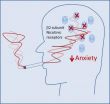(Press-News.org) Every six seconds, for millions of years, comets have been colliding with one another near a star in the constellation Cetus called 49 CETI, which is visible to the naked eye.
Over the past three decades, astronomers have discovered hundreds of dusty disks around stars, but only two — 49 CETI is one — have been found that also have large amounts of gas orbiting them.
Young stars, about a million years old, have a disk of both dust and gas orbiting them, but the gas tends to dissipate within a few million years and almost always within about 10 million years. Yet 49 CETI, which is thought to be considerably older, is still being orbited by a tremendous quantity of gas in the form of carbon monoxide molecules, long after that gas should have dissipated.
"We now believe that 49 CETI is 40 million years old, and the mystery is how in the world can there be this much gas around an otherwise ordinary star that is this old," said Benjamin Zuckerman, a UCLA professor of physics and astronomy and co-author of the research, which was recently published in the Astrophysical Journal. "This is the oldest star we know of with so much gas."
Zuckerman and his co-author Inseok Song, a University of Georgia assistant professor of physics and astronomy, propose that the mysterious gas comes from a very massive disk-shaped region around 49 CETI that is similar to the sun's Kuiper Belt, which lies beyond the orbit of Neptune.
The total mass of the various objects that make up the Kuiper Belt, including the dwarf planet Pluto, is about one-tenth the mass of the Earth. But back when the Earth was forming, astronomers say, the Kuiper Belt likely had a mass that was approximately 40 times larger than the Earth's; most of that initial mass has been lost in the last 4.5 billion years.
By contrast, the Kuiper Belt analogue that orbits around 49 CETI now has a mass of about 400 Earth masses — 4,000 times the current mass of the Kuiper Belt.
"Hundreds of trillions of comets orbit around 49 CETI and one other star whose age is about 30 million years. Imagine so many trillions of comets, each the size of the UCLA campus — approximately 1 mile in diameter — orbiting around 49 CETI and bashing into one another," Zuckerman said. "These young comets likely contain more carbon monoxide than typical comets in our solar system. When they collide, the carbon monoxide escapes as a gas. The gas seen around these two stars is the result of the incredible number of collisions among these comets.
"We calculate that comets collide around these two stars about every six seconds," he said. "I was absolutely amazed when we calculated this rapid rate. I would not have dreamt it in a million years. We think these collisions have been occurring for 10 million years or so."
Using a radio telescope in the Sierra Nevada mountains of southern Spain in 1995, Zuckerman and two colleagues discovered the gas that orbits 49 CETI, but the origin of the gas had remained unexplained for 17 years, until now.
###
UCLA is California's largest university, with an enrollment of more than 40,000 undergraduate and graduate students. The UCLA College of Letters and Science and the university's 11 professional schools feature renowned faculty and offer 337 degree programs and majors. UCLA is a national and international leader in the breadth and quality of its academic, research, health care, cultural, continuing education and athletic programs. Six alumni and six faculty have been awarded the Nobel Prize.
For more news, visit the UCLA Newsroom and follow us on Twitter.
Comet collisions every 6 seconds explain 17-year-old stellar mystery
2012-11-09
ELSE PRESS RELEASES FROM THIS DATE:
Is housework a health hazard? Sheet-Fitting palsy described by wake forest baptist physicians
2012-11-09
WINSTON-SALEM, N.C. – Nov. 8, 2012 – What do a tight, fitted bed sheet and a blood clot in the wrist have in common? Both are associated with a condition called sheet fitting palsy. True to its name, the palsy is reported in those who spend a long period of time repeatedly trying to pull a fitted bed sheet over the corner of a mattress. But it has also been reported in basketball players and in those who do push-ups as exercise.
The injury is caused by the continuous flexing movement of the wrist and results in a tiny stroke in the artery to the hand. The resulting ...
More bang for the biofuel buck
2012-11-09
A fermentation technique once used to make cordite, the explosive propellant that replaced gunpowder in bullets and artillery shells, may find an important new use in the production of advanced biofuels. With the addition of a metal catalyst, researchers at the U.S. Department of Energy (DOE)'s Lawrence Berkeley National Laboratory (Berkeley Lab) have shown that the production of acetone, butanol and ethanol from lignocellulosic biomass could be selectively upgraded to the high volume production of gasoline, diesel or jet fuel.
Using the bacterium Clostridium acetobutylicum, ...
Diabetes study: 'Mindful eating' equals traditional education in lowering weight and blood sugar
2012-11-09
COLUMBUS, Ohio – Eating mindfully, or consuming food in response to physical cues of hunger and fullness, is just as effective as adhering to nutrition-based guidelines in reducing weight and blood sugar levels in adults with Type 2 diabetes, a new study suggests.
In a comparison study of the effectiveness of the two types of behavioral interventions, participants lost about the same amount of weight – an average of between 3 1/2 and 6 pounds – and lowered their long-term blood sugar levels significantly after three months.
One treatment group followed an established ...
Taking on the challenges of replication in psychological science
2012-11-09
Psychological science has come of age. But the rights of a mature discipline carry with them responsibilities, among them the responsibility to maximize confidence in our findings through good data practices and replication.
The November issue of Perspectives on Psychological Science, a journal of the Association for Psychological Science (APS), reflects the discipline's ongoing commitment to examine methodological issues that affect all areas of science — such as failures to replicate previous findings and problems of bias and error — with the goal of strengthening our ...
Researchers find why nicotine in cigarettes may relieve anxiety in smokers
2012-11-09
RICHMOND, Va. (Nov. 9, 2012) – Preclinical data suggests inactivation of a specific sub-class of nicotinic receptors may be an effective strategy to help smokers quit without feeling anxious, according to Virginia Commonwealth University researchers.
These findings could one day point researchers to the development of novel therapies to help smokers quit without feeling anxious.
Smokers use cigarettes for many reasons, but many report that they smoke to relieve anxiety, despite the health danger of cigarette smoking. Researchers are now working to understand the underlying ...
Examining transition from student to teacher
2012-11-09
Montreal, November 8, 2012 – "It was the hardest thing I ever had to do, emotionally and mentally." These are not the words we generally associate with a university student who is undergoing teacher training, yet Concordia researcher Anita Sinner has heard similar statements from many such individuals. Every year thousands of students make the transition from student to teacher and the stories of those who struggle are often missing from our conversations.
"Pre-service teachers who experience varying degrees of struggle have few stories against which to compare their ...
When identity is tied to former employer, unemployed report higher well-being
2012-11-09
SAN FRANCISCO, Nov. 1, 2012-- Unemployed workers who continue to identify with their former employer report higher well-being even after being fired or laid off from the company, according to a study published Nov. 9 in the Journal of Managerial Psychology.
The study, conducted by San Francisco State University Assistant Professor of Management Jennifer Tosti-Kharas, is among the first to explore how organizational identification relates to job loss.
"These unemployed people have something to cling to by having had very positive associations with their employer in the ...
A potentially deadly reason to seek preventive health care
2012-11-09
ANAHEIM, CA. (November 9, 2012) – Emergency rooms are more crowded than ever, with more than 136 million people making a trip annually. According to a study presented at the American College of Allergy, Asthma and Immunology (ACAAI) 2012 Annual Scientific Meeting, some of these trips may be preventable under the regular care of an allergist. Such care may also save lives.
Researchers found 25 percent of individuals who went to the emergency room or were hospitalized for anaphylaxis, a life-threatening allergic reaction, had severe anaphylaxis, which required hospitalization ...
Blackberry vs. iPhone -- There is a winner, for your health
2012-11-09
ANAHEIM, CA. (November 9, 2012) – The Blackberry vs. iPhone battle has been ongoing since Apple's 2007 phone debut, with no end in sight. That is until today. According to a study being presented at the Annual Scientific Meeting of the American College of Allergy, Asthma and Immunology (ACAAI), there is a clear winner when it comes to your health.
With more than 285 million cell phone subscribers in the United States, ACAAI allergists studied popular smartphones for two common allergens, cobalt and nickel.
"Approximately one-third of all Blackberries contain nickel, ...
An egg a day to keep allergies away
2012-11-09
ANAHEIM, CA. (November 9, 2012) – Avoiding sweet treats like pumpkin bread and cookies this holiday season might not be necessary for children with egg allergies. New studies presented at the American College of Allergy, Asthma and Immunology (ACAAI) Annual Scientific Meeting found 56 percent of allergic children can tolerate baked hen's egg, while 55 percent outgrow their egg allergy entirely.
"More than half of egg allergic children can tolerate hen's eggs when they are baked at 350 degrees in products such as cakes and breads," said allergist Rushani Saltzman, M.D., ...

